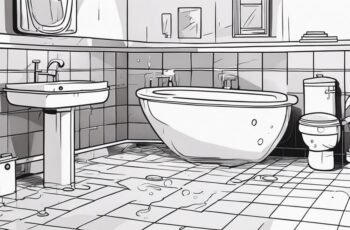Have you ever found yourself ankle-deep in a septic tank dilemma, wondering where it all went wrong? Picture this: water backing up, foul odors wafting through your yard, and sinks draining slower than a tortoise.
It's enough to make you want to call in the experts, but what if you could tackle the issue head-on yourself? In the following account, you'll discover firsthand the trials and triumphs of troubleshooting septic tank drainage problems, offering insights that might just save your sanity – and your wallet.
Key Takeaways
- Regular maintenance prevents septic tank issues.
- Prompt professional help is crucial for troubleshooting.
- Foul odors and slow drainage signal problems.
- Early indicators like gurgling sounds shouldn't be ignored.
Common Signs of a Full Septic Tank

If you notice slow drains, gurgling noises, or sewage odors in your home, these are common signs indicating a full septic tank that requires attention. Regular maintenance is crucial to prevent these issues.
When your septic tank is full, odors can seep into your home, creating unpleasant living conditions. To tackle this, ensure that your septic system receives proper care and attention. Odor control can be achieved by scheduling routine pump-outs to remove accumulated solids and prevent backups.
Neglecting regular maintenance can lead to a myriad of problems, including foul odors permeating your household. By staying proactive and addressing these warning signs promptly, you can maintain a healthy septic system.
Warning Signals of a Failing System
To identify warning signals of a failing septic system, pay close attention to unusual wet spots in your yard or standing water around the drain field. These signs could indicate potential issues such as clogs or system overload. Additionally, if you notice slow drainage in sinks, toilets, or showers, it might be a red flag for impending septic problems. Foul odors lingering in your yard or backing up into your home also signify possible system failures that need immediate attention. Another warning signal is lush, green grass over the drain field, which could suggest a leaking septic system.
Preventive maintenance is crucial to avoid septic system failures. Regular inspections, pumping every 3-5 years, and proper waste disposal can extend the life of your system. Troubleshooting tips include watching for warning signals, keeping accurate records of maintenance, and seeking professional help at the first sign of trouble. By staying vigilant and proactive, you can prevent costly repairs and ensure your septic system functions optimally.
Early Indicators of Drainage Issues

Early indicators of drainage issues typically manifest as slow draining fixtures, gurgling sounds from drains, or pooling water near the septic tank. When you notice these signs, it's crucial to take action promptly to prevent further complications. Prevention methods are key in maintaining a healthy septic system. Regular inspections by a professional can help identify potential drainage issues early on, allowing for timely intervention. Additionally, being mindful of what goes down your drains can significantly impact the health of your septic tank.
If you encounter early drainage problems, there are some DIY solutions you can try before seeking professional help. Flushing your system with a septic-safe cleaner can help alleviate minor clogs and improve drainage. Ensuring that your septic tank isn't overloaded with water by fixing leaks or using water-saving fixtures can also aid in preventing drainage issues. However, if these DIY methods fail to resolve the problem, it's best to consult a septic system expert for a thorough assessment.
Red Flags for Septic Tank Problems
Common red flags indicating septic tank problems include foul odors emanating from drains, slow drainage across multiple fixtures, and unusually lush patches of grass near the drain field. These signs often point to underlying issues that require prompt attention to prevent costly repairs.
When foul smells start wafting from your drains, it indicates a potential problem with the septic tank's integrity or the drainage system. Slow drainage across various fixtures in your home suggests a blockage or backup within the septic system. Additionally, if you notice patches of extremely healthy and lush grass near the drain field, it could signify a leaking or overflowing septic tank.
To avoid these red flags, regular maintenance is crucial. Pumping your septic tank every 3-5 years and being mindful of what goes down your drains can prevent many common issues. Root causes of septic tank problems often stem from lack of maintenance, excessive water usage, or improper disposal of non-biodegradable items.
Conclusion
In conclusion, proper maintenance of your septic tank is crucial to prevent drainage issues. Ignoring warning signs can lead to costly repairs and potential health hazards.
For example, a homeowner in rural Texas neglected routine septic tank pumping and suffered from sewage backup in their yard.
Don't wait until it's too late – be proactive in addressing any potential problems with your septic system to avoid major headaches down the road.

